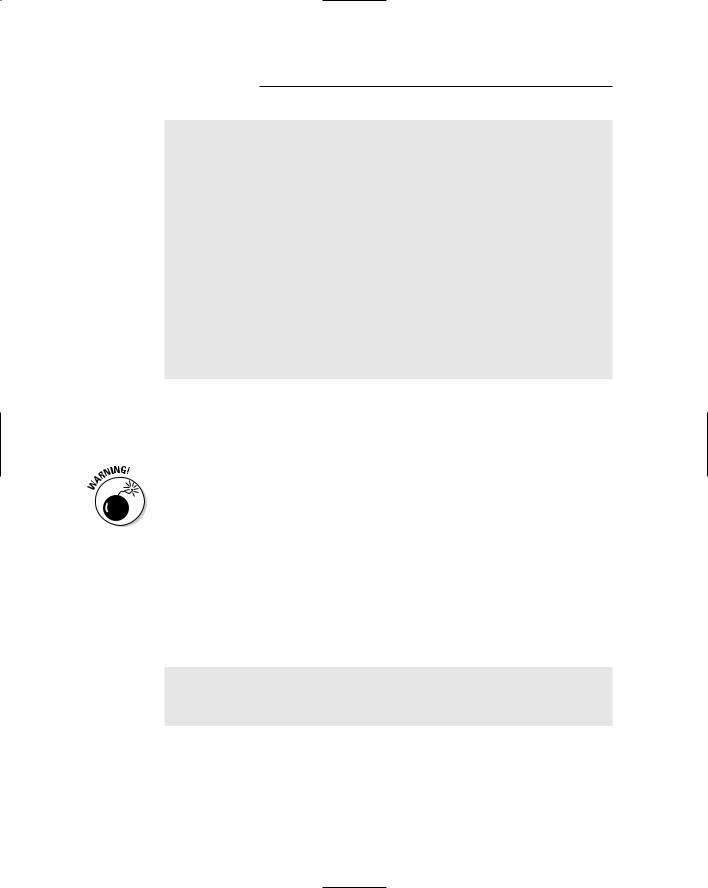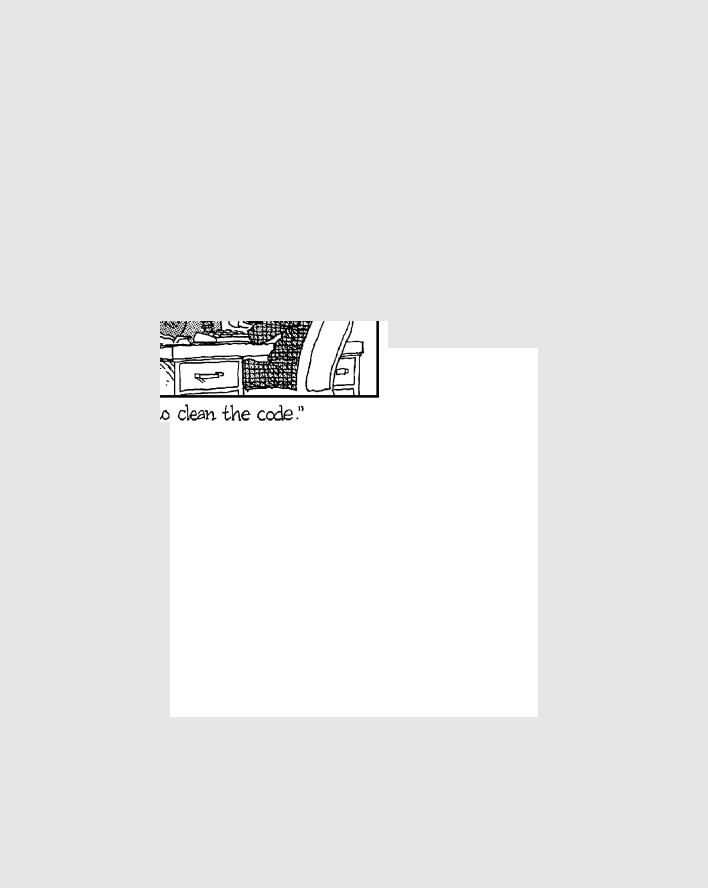
- •Table of Contents
- •Introduction
- •What Is C++?
- •Conventions Used in This Book
- •How This Book Is Organized
- •Part I: Introduction to C++ Programming
- •Part III: Introduction to Classes
- •Part IV: Inheritance
- •Part V: Optional Features
- •Part VI: The Part of Tens
- •Icons Used in This Book
- •Where to Go from Here
- •Grasping C++ Concepts
- •How do I program?
- •Installing Dev-C++
- •Setting the options
- •Creating Your First C++ Program
- •Entering the C++ code
- •Building your program
- •Executing Your Program
- •Dev-C++ is not Windows
- •Dev-C++ help
- •Reviewing the Annotated Program
- •Examining the framework for all C++ programs
- •Clarifying source code with comments
- •Basing programs on C++ statements
- •Writing declarations
- •Generating output
- •Calculating Expressions
- •Storing the results of expression
- •Declaring Variables
- •Declaring Different Types of Variables
- •Reviewing the limitations of integers in C++
- •Solving the truncation problem
- •Looking at the limits of floating-point numbers
- •Declaring Variable Types
- •Types of constants
- •Special characters
- •Are These Calculations Really Logical?
- •Mixed Mode Expressions
- •Performing Simple Binary Arithmetic
- •Decomposing Expressions
- •Determining the Order of Operations
- •Performing Unary Operations
- •Using Assignment Operators
- •Why Mess with Logical Operations?
- •Using the Simple Logical Operators
- •Storing logical values
- •Using logical int variables
- •Be careful performing logical operations on floating-point variables
- •Expressing Binary Numbers
- •The decimal number system
- •Other number systems
- •The binary number system
- •Performing Bitwise Logical Operations
- •The single bit operators
- •Using the bitwise operators
- •A simple test
- •Do something logical with logical calculations
- •Controlling Program Flow with the Branch Commands
- •Executing Loops in a Program
- •Looping while a condition is true
- •Using the for loop
- •Avoiding the dreaded infinite loop
- •Applying special loop controls
- •Nesting Control Commands
- •Switching to a Different Subject?
- •Writing and Using a Function
- •Divide and conquer
- •Understanding the Details of Functions
- •Understanding simple functions
- •Understanding functions with arguments
- •Overloading Function Names
- •Defining Function Prototypes
- •Variable Storage Types
- •Including Include Files
- •Considering the Need for Arrays
- •Using an array
- •Initializing an array
- •Accessing too far into an array
- •Using arrays
- •Defining and using arrays of arrays
- •Using Arrays of Characters
- •Creating an array of characters
- •Creating a string of characters
- •Manipulating Strings with Character
- •String-ing Along Variables
- •Variable Size
- •Address Operators
- •Using Pointer Variables
- •Comparing pointers and houses
- •Using different types of pointers
- •Passing Pointers to Functions
- •Passing by value
- •Passing pointer values
- •Passing by reference
- •Limiting scope
- •Examining the scope problem
- •Providing a solution using the heap
- •Defining Operations on Pointer Variables
- •Re-examining arrays in light of pointer variables
- •Applying operators to the address of an array
- •Expanding pointer operations to a string
- •Justifying pointer-based string manipulation
- •Applying operators to pointer types other than char
- •Contrasting a pointer with an array
- •Declaring and Using Arrays of Pointers
- •Utilizing arrays of character strings
- •Identifying Types of Errors
- •Choosing the WRITE Technique for the Problem
- •Catching bug #1
- •Catching bug #2
- •Calling for the Debugger
- •Defining the debugger
- •Finding commonalities among us
- •Running a test program
- •Single-stepping through a program
- •Abstracting Microwave Ovens
- •Preparing functional nachos
- •Preparing object-oriented nachos
- •Classifying Microwave Ovens
- •Why Classify?
- •Introducing the Class
- •The Format of a Class
- •Accessing the Members of a Class
- •Activating Our Objects
- •Simulating real-world objects
- •Why bother with member functions?
- •Adding a Member Function
- •Creating a member function
- •Naming class members
- •Calling a Member Function
- •Accessing a member function
- •Accessing other members from a member function
- •Defining a Member Function in the Class
- •Keeping a Member Function After Class
- •Overloading Member Functions
- •Defining Arrays of and Pointers to Simple Things
- •Declaring Arrays of Objects
- •Declaring Pointers to Objects
- •Dereferencing an object pointer
- •Pointing toward arrow pointers
- •Passing Objects to Functions
- •Calling a function with an object value
- •Calling a function with an object pointer
- •Calling a function by using the reference operator
- •Returning to the Heap
- •Comparing Pointers to References
- •Linking Up with Linked Lists
- •Performing other operations on a linked list
- •Hooking up with a LinkedListData program
- •A Ray of Hope: A List of Containers Linked to the C++ Library
- •Protecting Members
- •Why you need protected members
- •Discovering how protected members work
- •Protecting the internal state of the class
- •Using a class with a limited interface
- •Creating Objects
- •Using Constructors
- •Why you need constructors
- •Making constructors work
- •Dissecting a Destructor
- •Why you need the destructor
- •Working with destructors
- •Outfitting Constructors with Arguments
- •Justifying constructors
- •Using a constructor
- •Defaulting Default Constructors
- •Constructing Class Members
- •Constructing a complex data member
- •Constructing a constant data member
- •Constructing the Order of Construction
- •Local objects construct in order
- •Static objects construct only once
- •Global objects construct in no particular order
- •Members construct in the order in which they are declared
- •Destructors destruct in the reverse order of the constructors
- •Copying an Object
- •Why you need the copy constructor
- •Using the copy constructor
- •The Automatic Copy Constructor
- •Creating Shallow Copies versus Deep Copies
- •Avoiding temporaries, permanently
- •Defining a Static Member
- •Why you need static members
- •Using static members
- •Referencing static data members
- •Uses for static data members
- •Declaring Static Member Functions
- •What Is This About, Anyway?
- •Do I Need My Inheritance?
- •How Does a Class Inherit?
- •Using a subclass
- •Constructing a subclass
- •Destructing a subclass
- •Having a HAS_A Relationship
- •Why You Need Polymorphism
- •How Polymorphism Works
- •When Is a Virtual Function Not?
- •Considering Virtual Considerations
- •Factoring
- •Implementing Abstract Classes
- •Describing the abstract class concept
- •Making an honest class out of an abstract class
- •Passing abstract classes
- •Factoring C++ Source Code
- •Defining a namespace
- •Implementing Student
- •Implementing an application
- •Project file
- •Creating a project file under Dev-C++
- •Comparing Operators with Functions
- •Inserting a New Operator
- •Overloading the Assignment Operator
- •Protecting the Escape Hatch
- •How Stream I/O Works
- •The fstream Subclasses
- •Reading Directly from a Stream
- •Using the strstream Subclasses
- •Manipulating Manipulators
- •Justifying a New Error Mechanism?
- •Examining the Exception Mechanism
- •What Kinds of Things Can I Throw?
- •Adding Virtual Inheritance
- •Voicing a Contrary Opinion
- •Generalizing a Function into a Template
- •Template Classes
- •Do I Really Need Template Classes?
- •Tips for Using Templates
- •The string Container
- •The list Containers
- •Iterators
- •Using Maps
- •Enabling All Warnings and Error Messages
- •Insisting on Clean Compiles
- •Limiting the Visibility
- •Avoid Overloading Operators
- •Heap Handling
- •Using Exceptions to Handle Errors
- •Avoiding Multiple Inheritance
- •Customize Editor Settings to Your Taste
- •Highlight Matching Braces/Parentheses
- •Enable Exception Handling
- •Include Debugging Information (Sometimes)
- •Create a Project File
- •Customize the Help Menu
- •Reset Breakpoints after Editing the File
- •Avoid Illegal Filenames
- •Include #include Files in Your Project
- •Executing the Profiler
- •System Requirements
- •Using the CD with Microsoft Windows
- •Using the CD with Linux
- •Development tools
- •Program source code
- •Index

368 Part V: Optional Features
Input a name (input an x to terminate list) Adams
Davis Valentine Smith Wilson
x
Sorted output:
Adams
Davis
Smith
Valentine
Wilson
Press any key to continue . . .
The list container provides a large set of operators. Simple operations include insert, swap, and erase. This same container also gives the pro grammer the ability to automatically iterate through the list invoking the same user-defined function on each object.
The operation that the list cannot provide is random access. Because objects can be snapped together in any order, there is no quick way for the list class to return the nth object.
Iterators
The STLList sample program presented in the prior section uses a destruc tive approach to iterating through the list. The pop_front() method moves the user through the list by removing the first object in each case.
The programmer iterates through an array by providing the index of each ele ment. However, this technique doesn’t work for containers like list that don’t allow for random access. One could imagine a solution based upon methods such as getFirst() and getNext(); however, the designers of the STL wanted to provide a common method for traversing any type of container. For this, the STL defines the iterator.
An iterator is an object that points to the members of a container. In general, every iterator supports the following functions:
A class can return an iterator that points to the first member of the collection.
The iterator can be moved from one member to the next.
The program can retrieve the element pointed to by the iterator.

Chapter 28: Standardizing on the Standard Template Library 369
The code necessary to iterate through a list is different from that necessary to traverse a vector (to name just two examples). However, the iterator hides these details.
The following STLListUserClass program uses an iterator to traverse an STL list in a non-destructive way:
// STLListUserClass - use a list to contain and sort a // user defined class
#include <list> #include <string> #include <cstdio> #include <cstdlib> #include <iostream>
using namespace std;
//Student - some example user defined class class Student
{
public:
Student(char* pszName, int id)
{
name = new string(pszName); ssID = id;
}
string* name; int ssID;
};
//the following function is required to support the
//sort operation
bool operator<(Student& s1, Student& s2)
{
return s1.ssID < s2.ssID;
}
// define the collection of students list<Student> students;
int main(int argc, char* pArgs[])
{
//add three student objects to the list students.push_back(*new Student(“Marion Haste”, 10)); students.push_back(*new Student(“Dewie Cheatum”, 5)); students.push_back(*new Student(“Stew Dent, Sr.”, 15));
//now sort the list
students.sort();
//and iterate through the list:
//1) allocate an iterator that points to the first
//element in the list

370 Part V: Optional Features
list<Student>::iterator iter = students.begin();
//2) continue to loop through the list until the iterator
//hits the end of the list
while(iter != students.end())
{
// 3) retrieve the Student that the iterator points at Student& s = *iter;
cout << s.ssID << “ - “ << *s.name << endl;
//4) now move the iterator over to the next element
//int the list
iter++;
}
system(“PAUSE”); return 0;
}
This program defines a list of user-defined Student objects (rather than simple names). Three calls to push_back() add elements to the list (hard coding these calls keeps the program smaller). The call to sort() is the same as that used in the STLList program.
The sort() function within the Standard Template Library classes
requires the user to overload the “less than” operator. (This is one of the few places where a user-defined operator other than assignment is required.) operator<(Student&, Student&) is invoked by the expression s1 < s2 when both s1 and s2 are of type Student.
The program allocates an iterator iter to navigate its way through the list. Look carefully at the iterator declaration: list<Student>::iterator is an iterator to a list container of Student objects. The strong typing is demon strated clearly by the assignment (see Step 3 in preceding code): *iter returns a reference to a Student object.
The output of this program appears as follows:
5 - Dewie Cheatum
10 - Marion Haste
15 - Stew Dent, Sr.
Press any key to continue . . .

Chapter 28: Standardizing on the Standard Template Library 371
How a sort() sorts
I have glossed over an interesting point: How does the sort() method know which of two elements in the list is “bigger”? In other words, what determines the sort order? C++ defines its own sorting order for some types. For example, C++ knows which of two ints is larger. In addi tion, the STL sorted the collection of ASCII strings contained in the name collection using the same rules that a dictionary uses.
The STLList program did not need to take any special measures when sorting names. C++ does not know which of two Student objects
is larger — the global function ::operator <(Student&, Student&) serves this pur pose. The sort() method invokes this function as it makes its way through the list to determine the proper sort order.
As an experiment, reverse the sense of the operator<() function as follows:
return s1.ssID > s2.ssID;
The result is a list sorted in the exact opposite direction.
Using Maps
Maps are one other class of collection. There are a number of different types of maps, but they all share a common property: Maps are designed to allow elements to be stored and retrieved quickly according to some key or index. The following next program demonstrates the principle.
For example, a school may register students by a unique identification number. This ID is used in every facet of school life. This ID is used to retrieve student information, check out books from the library, and assign grades in courses. It is important that any program be able to retrieve a stu dent by his or her student ID quickly and efficiently.
The following STLMap program creates and uses a collection of Student objects, which are keyed by ID:
//STLMap - use a map container to retain a collection of
//objects ordered by a key
#include <cstdio> #include <cstdlib> #include <iostream> #include <sstream> #include <string> #include <map>

372 Part V: Optional Features
using namespace std;
//SC - Student comparison function; designed to determine
//the sorting order of the students
struct SC
{
bool operator()(const int id1, const int id2) const
{
return id1 < id2;
}
};
//the map actually contains a Pair; the left element
//being the key while the right element is the data (in
//this case Student)
class Student; typedef Student* SP;
typedef pair<const int, Student*> Pair; typedef map<int, SP, SC> Map;
typedef map<int, SP, SC>::iterator MapIterator;
//collection of Students Map students;
//Student - define the important properties of a student
//including the key use when looking him/her up
//from the student rolls(student id)
class Student
{
public:
Student(char* pszName, int id)
:studentIDKey(id), name(pszName) {}
//getKey - the key is used as an index into the map const int getKey() { return studentIDKey; }
//display - create a meaningful output
//for a Student object
string display()
{
ostringstream out;
out << studentIDKey << “ - “ << name; return out.str();
}
protected:
//Student elements are keyed by student id const int studentIDKey;
//the name of the student (plus any other data) string name;
};
int main(int argc, char* pArgs[])

Chapter 28: Standardizing on the Standard Template Library 373
{
//add a few of students to the students collection -
//a map actually stores objects as “pairs” with the
//left member being the key and the right the actual
object Student* pS;
pS = new Student(“Sean Yours”, 3456); Pair* ptr = new Pair(pS->getKey(), pS); students.insert(*ptr);
//a map overloads the index operator to create the Pair
//and insert it into the map for us
students[1234] = new Student(“Fresch Man”, 1234); students[5678] = new Student(“Student, Jr.”, 5678);
//iterate through the collection of students;
//a map is always retained in the sorted order
//determined by the SC class
cout << “Sorted list of students:” << endl; MapIterator iter = students.begin(); while(iter != students.end())
{
Pair p = *iter; Student* s = p.second;
cout << s->display() << endl; iter++;
}
//the increment and decrement operator can also be used
//to find the successor and predecessor
cout << “\nLook up student 3456” << endl; MapIterator p = students.find(3456);
cout << “Found student “ << p->second->display() << endl;
MapIterator p1 = p;
MapIterator prior = --p1; // <- predecessor cout << “Predecessor = “
<< prior->second->display() << endl;
MapIterator p2 = p;
MapIterator successor = ++p2; // <-successor cout << “Successor = “
<<successor->second->display() << endl;
//find() returns the end iterator when it can’t find the
//object in question; operator[] returns a NULL
if (students.find(0123) == students.end())
{
cout << “The call students.find(0123) returns “
<<“students.end() since student 0123 doesn’t exist”
<<endl;
}

374 Part V: Optional Features
// output using index
cout << “To test index: students[3456] = “ << students[3456]->display() << endl;
if (students[0123] == NULL)
{
cout << “but students[0123] returns a NULL” << endl;
}
system(“PAUSE”); return 0;
}
The key to the program (if you can pardon the pun) is found in the initial three typedefs. A map contains a set of Pair objects, each of which contains a first and second element. The first element is the student ID key, and the second is the Student object. The Map class adds an object of class SC. This class con tains a single method that compares two Student objects to determine which is larger. (This is slightly more complicated than the global function used with the list collection, but the effect is the same.)
The STLMap program begins by creating three Student Pair objects and adding them to the list. The iteration through the container displays the Student objects in order by student ID. There is no need to invoke a sort() method because map classes already retain objects sorted by key.
The second section of the STLMap program looks up a student by ID using the find() method. The program also demonstrates how easy it is to retrieve the prior and next objects in the list using the decrement and increment operators.
The output from the program appears as follows:
Sorted list of students: 1234 - Fresch Man
3456 - Sean Yours
5678 - Student, Jr.
Look up student 3456
Found student 3456 - Sean Yours
Predecessor = 1234 - Fresch Man
Successor = 5678 - Student, Jr.
The call students.find(0123) returns students.end() since student 0123 doesn’t exist
To test index: students[3456] = 3456 - Sean Yours but students[0123] returns a NULL
Press any key to continue . . .

Part VI
The Part of Tens

In this part . . .
What For Dummies book would be complete without a Part of Tens? In Chapter 29, I cover ten ways to
avoid adding bugs to your C++ program. (Most of these suggestions work for C programs too, at no extra charge.) Chapter 30 lists the ten most important compiler options available in the Dev-C++ compiler, which is available to the reader on the enclosed CD-ROM.
